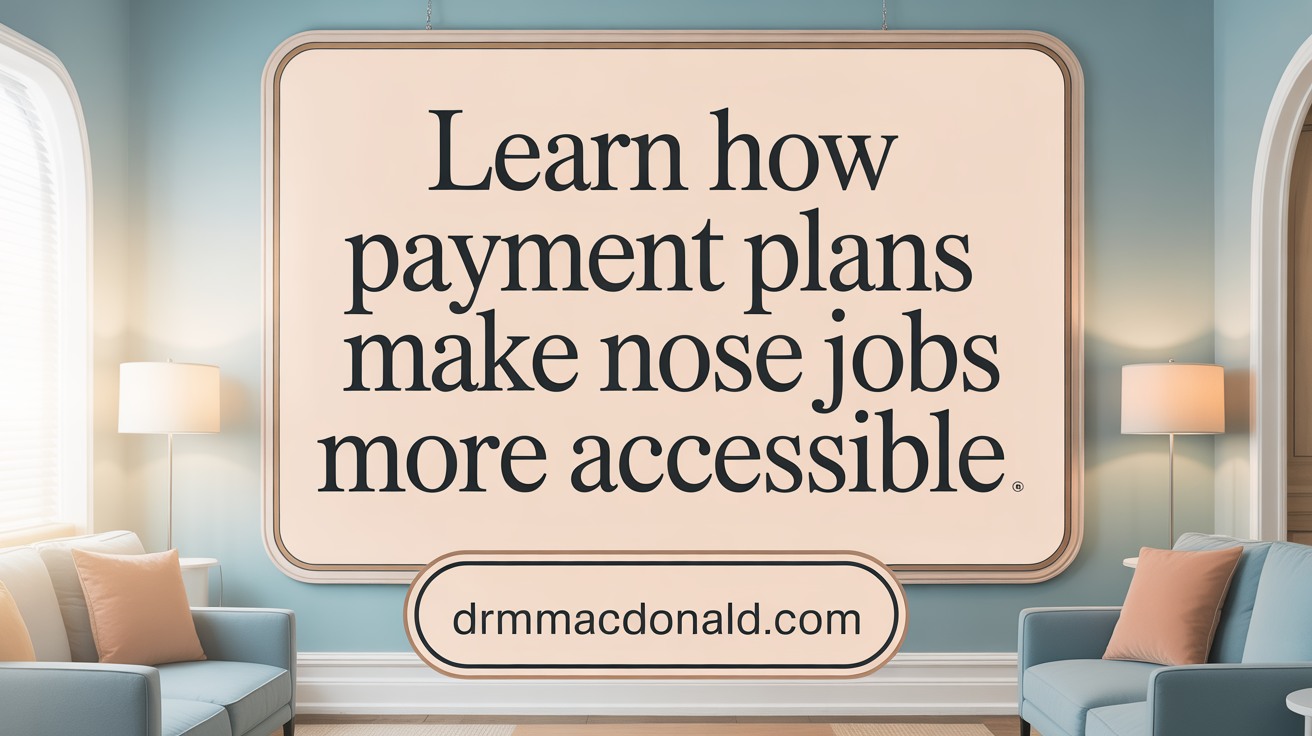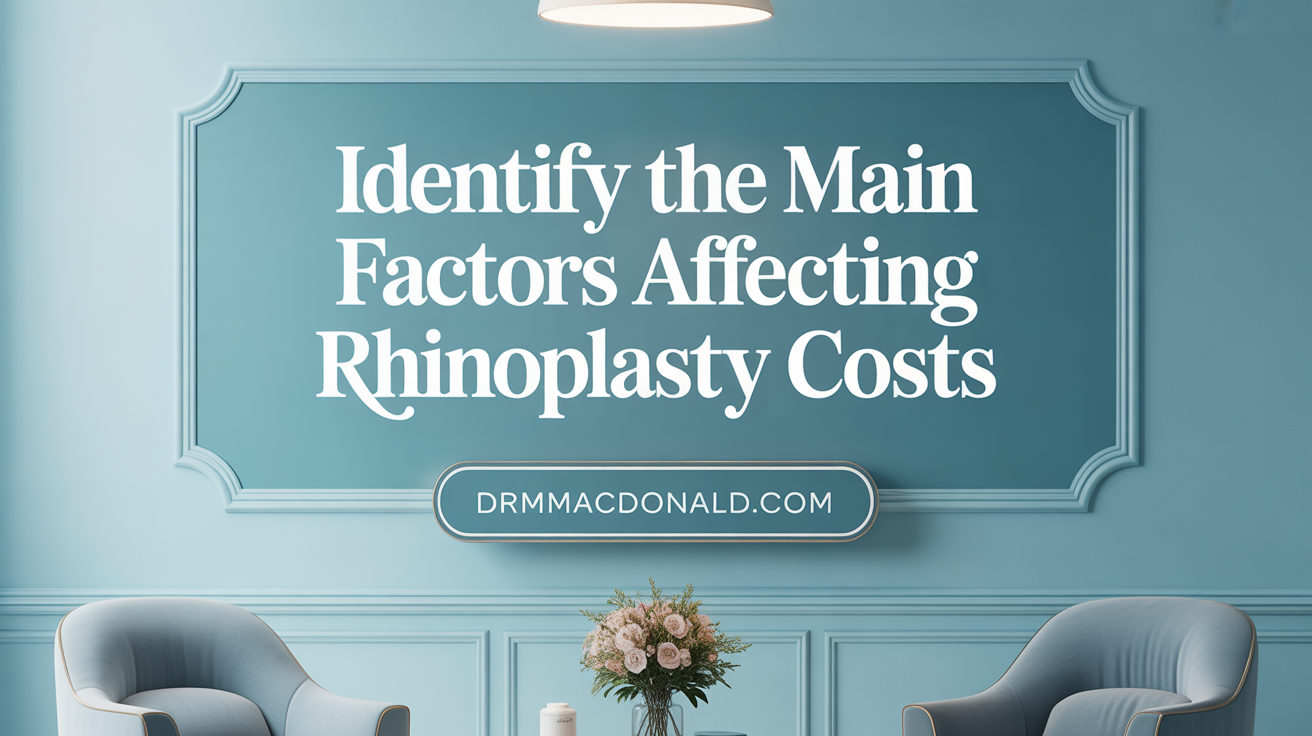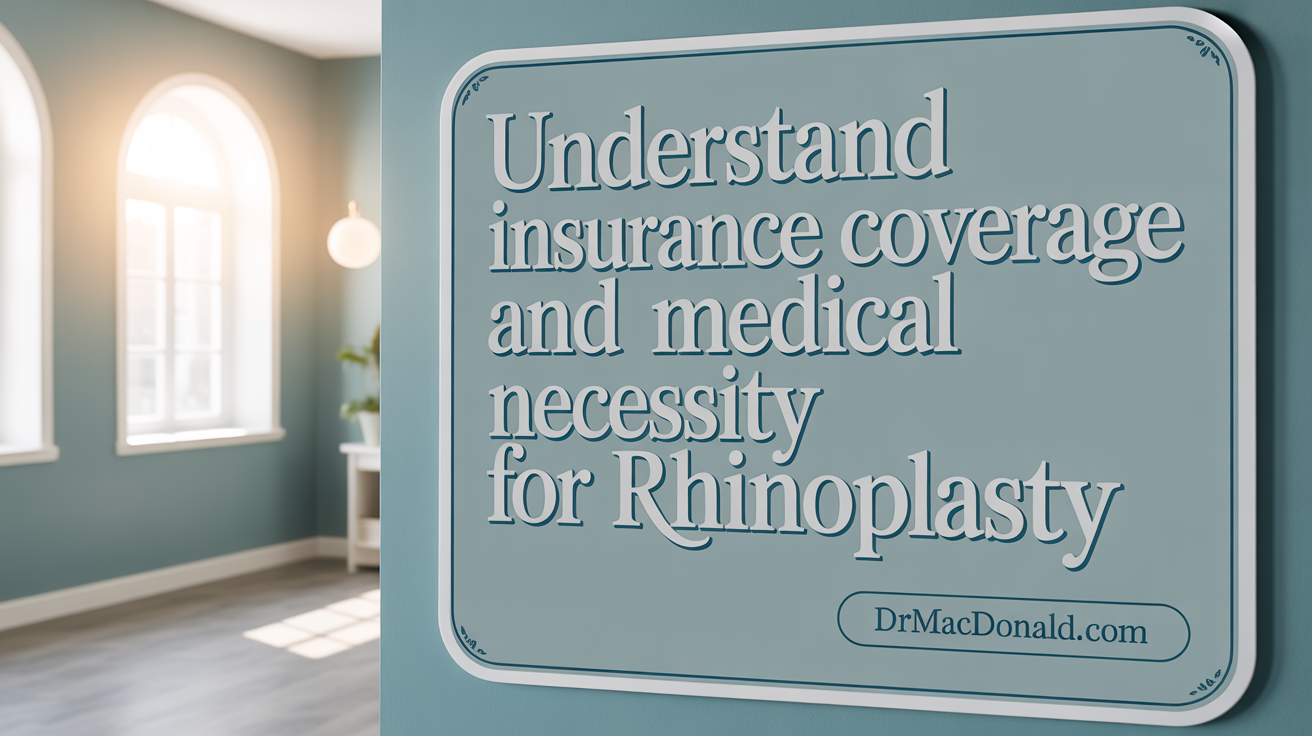Understanding the Financial Path to Your Dream Nose Job
Rhinoplasty, commonly known as a nose job, is a transformative surgery that can boost confidence and improve nasal function. Yet, the cost is often seen as a hurdle for many considering this procedure. Fortunately, an array of financing solutions exists to make this dream achievable. This article delves into the key financial aspects, available payment options, and practical strategies to make rhinoplasty affordable without compromising quality and safety.
Exploring Financing Options for Rhinoplasty
Many people considering rhinoplasty, or a nose job, find the high cost to be a barrier to getting their desired procedure. To make this surgery more accessible, various financial strategies have become available.
Common financing methods include clinic-sponsored payment plans, medical loans, and credit cards designed specifically for healthcare expenses. Several clinics, like the Portland Center for Facial Plastic Surgery, offer flexible installment plans with little or no interest, allowing patients to pay over time without high additional costs.
Specialized healthcare financing providers play a crucial role in making rhinoplasty more affordable. Companies like Medicard by iFinance are recognized across Canada and partner with thousands of medical, dental, and veterinary clinics. Patients can apply online for a Medicard loan, often receiving pre-approval quickly, and use the funds directly for their surgery. These loans range from $500 to $25,000, with repayment periods from 12 to 72 months. One of the advantages of such loans is that they do not require a down payment or collateral, and early repayment carries no penalties.
Additionally, other financing options include paying via credit cards with promotional low-interest rates, personal bank loans, or in-house clinic financing, which can simplify the payment process. Many patients also explore the use of Health Savings Accounts (HSAs) or Flexible Spending Accounts (FSAs) if their procedure addresses medical issues like a deviated septum, potentially leading to partial insurance coverage.
Applying for these financial plans is often straightforward. Many providers, like Beautifi, allow online applications, which typically result in quick pre-approval. This process enables patients to plan their finances more effectively and proceed with their surgery without delaying due to cost concerns.
The range of available loans and repayment terms gives patients flexibility. Loan amounts usually cover either part or the full surgical cost, and repayment periods typically span from one to six years. This variety ensures that most patients can find a plan suited to their financial situation,
| Financing Provider | Loan Range | Repayment Duration | Notable Features |
|---|---|---|---|
| Medicard by iFinance | $500 - $25,000 | 12 - 72 months | No down payment, quick online approval, no early repayment penalties |
| Beautifi | Varies | Up to 84 months | 0% interest financing for qualified applicants |
| CareCredit | Varies | Flexible | Widely accepted, allows for multiple healthcare expenses |
Choosing the right financing method requires careful consideration of interest rates, repayment terms, and total costs. Proper planning can make rhinoplasty a realistic goal, helping individuals achieve both aesthetic and functional improvements without immediate financial strain.
How Payment Plans Enhance Rhinoplasty Affordability

How can payment plans make rhinoplasty more affordable?
Payment plans play a vital role in making rhinoplasty accessible to a broader range of patients. Instead of paying the entire procedure cost upfront, patients can opt for financing options that break down the expense into smaller, more manageable monthly payments.
Many clinics, including reputable centers like the Portland Center for Facial Plastic Surgery, offer flexible payment arrangements such as installment plans with little or no interest. These plans often do not require a large initial deposit, easing the immediate financial burden.
Benefits of payment plans
The primary benefit is financial flexibility. Patients no longer need to save a large sum before undergoing surgery. Instead, they can proceed with their procedures sooner, which can be especially important for those with time-sensitive aesthetic concerns or functional issues.
Payment plans also help with cash flow management. Patients can allocate their funds toward daily expenses and other priorities while spreading out the cost of their rhinoplasty.
Avoiding upfront financial burden
By choosing a financing option, patients avoid the stress of covering the total cost at once. This approach prevents the need for savings accumulation and reduces reliance on credit cards with high interest rates.
Typical terms and interest rates
For example, Medicard by iFinance, a widely accepted financing provider, offers loans from $500 to $25,000 with repayment terms from 12 to 72 months. These loans often come without requiring collateral or a down payment. Early repayment is usually penalty-free, giving patients further flexibility.
Interest rates vary depending on creditworthiness and the chosen plan but can be minimal or zero percent for promotional offers. Longer-term plans might include some interest, but they remain a convenient option for many.
Criteria for eligibility and application process
Eligibility primarily depends on credit checks and income verification. Patients can often apply online for quick pre-approval, making the process efficient.
Clinics typically have partnerships with financing firms or credit providers like CareCredit or Beautifi, streamlining the application process. Approval decisions are usually quick, and funds can be used immediately for deposits or full procedures.
In summary, financial strategies such as payment plans and specialized loans are essential tools in reducing the barrier of high rhinoplasty costs. They empower patients to prioritize their health and aesthetic goals conveniently, ultimately increasing access to high-quality facial plastic surgery.
Key Cost Factors Influencing Rhinoplasty Pricing

What factors affect the cost of a nose job?
The price of a rhinoplasty can vary widely depending on several elements. The complexity of the procedure is a significant factor. For instance, a straightforward cosmetic nose job tends to cost less than a revision or reconstructive surgery that addresses more extensive issues.
Surgeon expertise and geographic location also influence costs. Experienced, board-certified surgeons in metropolitan areas typically charge higher fees due to their reputation and the higher cost of operating in these regions.
The surgical method—whether open or closed rhinoplasty—further impacts the overall expense. Open rhinoplasty involves an external incision and provides greater access for extensive reshaping, often requiring more surgical time and resources. Closed rhinoplasty, performed entirely through internal incisions, tends to be less costly.
Preoperative and postoperative expenses contribute to total costs as well. Pre-surgical consultations, medical tests, and photography are necessary steps. After surgery, costs for follow-up visits, medications, and potential revisions can add up.
Additional costs include anesthesia fees, operating facility charges, and possibly grafting materials if structural support is needed. Travel, time off work, and any complementary cosmetic treatments also influence the overall financial picture.
Understanding these factors can help prospective patients plan financially. Some clinics offer flexible payment plans, medical financing, or use Health Savings Accounts (HSAs) and Flexible Spending Accounts (FSAs) to assist with expenses.
In summary, the total price for a nose job depends on the procedure’s complexity, surgeon’s experience, surgical approach, and associated pre- and post-operative costs. Considering these elements is essential to making an informed decision about affordability and choosing the right care provider.
| Cost Factor | Impact on Price | Additional Details |
|---|---|---|
| Procedure complexity | Higher complexity, higher cost | Revision surgeries or functional corrections tend to be more expensive |
| Surgeon’s experience | More experience, higher fee | Certified specialists in high-demand locations may charge more |
| Geographic location | Urban centers cost more | Metropolitan areas generally have higher facility and surgeon fees |
| Surgical method | Open vs. closed rhinoplasty | Open surgical approaches are typically more costly due to longer surgical time |
| Preoperative & postoperative care | Additional expenses | Consultations, tests, follow-ups, medications, and possible revision procedures |
| Additional costs | Ancillary expenses | Anesthesia, operating room fees, travel, and time off work |
Fostering resource planning and exploring financing options can make rhinoplasty more accessible, helping individuals balance their aesthetic goals with financial considerations.
Comparing Payment Plans, Loans, and Credit Options
 When considering rhinoplasty, understanding how different financing methods work can help make the procedure more accessible and manageable financially.
When considering rhinoplasty, understanding how different financing methods work can help make the procedure more accessible and manageable financially.
Clinic payment plans are often designed to be straightforward. Many clinics, such as the Portland Center for Facial Plastic Surgery, offer installment options that allow patients to pay their costs over time, often with little or no interest. These plans typically do not require a down payment or collateral, making them an attractive choice for reducing upfront financial burden. The application process is usually simple, with quick approval decisions often made online. The main benefit is ease of access and predictable payment schedules, but they may be limited in coverage for very high-cost procedures.
In contrast, external loans and credit options—such as medical loans, credit cards, and lines of credit—can provide larger sums of money if needed. These options may involve higher interest rates, especially if the applicant’s credit score is less than optimal. The approval process for credit cards or personal loans can take longer and may require stricter credit checks and documentation of income. Companies like Medicard or Affirm offer flexible repayment terms, from 12 to 72 months, and do not usually require collateral or down payments.
Here’s a comparison of these methods:
| Financing Method | Typical Interest Rates | Approval Timeline | Credit Requirements | Flexibility & Limits |
|---|---|---|---|---|
| Clinic Payment Plans | Usually 0% or low interest | Same day or within a few days | Usually minimal requirements | Smaller, installment payments; ideal for moderate costs |
| Medical Loans & Credit Lines | 5% to 20% or higher | Few hours to a few days | Fair to good credit often required | Larger sums available; may involve fees, higher costs |
The choice depends on your financial situation and how much you need to borrow. Payment plans are advantageous if you want simple, cost-effective installment payments directly through your clinic. For larger expenses or if you prefer to spread payments over a longer period, external loans or credit lines could be more appropriate.
Careful comparison of interest rates, repayment terms, application processes, and fees is essential. Patients with good credit and stable income often favor external loans for their flexibility, while those seeking quick, straightforward solutions may opt for clinic-sponsored payment plans. Evaluating your personal finances will help you select the option that best aligns with your budget and comfort.
Ultimately, resource planning and choosing the right financing method can make rhinoplasty more affordable, helping you achieve both aesthetic and functional improvements without financial stress.
Financial Planning Considerations Before Rhinoplasty
When preparing financially for rhinoplasty, it’s essential to understand the full scope of costs involved. The total price for the procedure can range from approximately $9,000 to $18,000 in Canada, covering surgeon’s fees, anesthesia, and operating facility expenses. Since most rhinoplasty procedures are elective, they are typically not covered by insurance, unless the surgery addresses functional issues such as a deviated septum.
Patients should explore flexible financing options to make the procedure more accessible. Clinics often offer payment plans, and third-party services like Medicard, Affirm, or Beautifi can provide medical loans or installment plans. These options allow for spreading payments over several months or years, with some offering pre-approval and instant credit decisions, simplifying the financial process.
Evaluating individual budgets and credit ratings is key to ensuring monthly payments will be manageable. It’s wise to avoid overextending financially and to choose plans with reasonable interest rates and terms that fit your financial situation. Consider the total cost, including potential additional expenses like pre-operative blood tests, post-operative follow-up care, and any revision procedures if needed.
Furthermore, patients should prioritize selecting qualified, board-certified surgeons and reputable medical facilities. The quality and safety of your surgery depend significantly on the expertise and credentials of your healthcare team. Combining prudent financial planning with careful surgeon selection can lead to not only satisfying aesthetic results but also a safe surgical experience.
Medical and Insurance Considerations in Rhinoplasty Financing

When might insurance cover rhinoplasty costs?
Insurance coverage for rhinoplasty primarily depends on whether the surgery addresses medical issues rather than purely aesthetic concerns. If the procedure aims to correct problems such as a deviated septum, nasal polyps, or other functional nasal issues that impair breathing, insurance may cover part or all of the costs.
What diagnostic criteria are involved?
To qualify for insurance coverage, documentation of medical necessity is typically required. This involves diagnostic tests and assessments confirming conditions like a deviated septum or sinus problems. Clear medical records and evaluations help substantiate the need for functional rhinoplasty.
What is the pre-approval process?
Insurance companies often require pre-approval before surgery. This includes detailed documentation from ENT specialists or facial plastic surgeons outlining the medical diagnosis and why surgery is necessary. Pre-approval ensures coverage eligibility and prevents unforeseen expenses.
How does insurance impact overall funding?
Insurance coverage decreases the out-of-pocket expense for patients when the procedure is medically necessary, reducing the financial burden. However, cosmetic enhancements without medical justification usually aren’t covered, meaning many patients rely on financing options or savings for such procedures.
Difference between cosmetic and functional rhinoplasty coverage
Cosmetic rhinoplasty, aimed solely at aesthetic improvements, is usually not covered by insurance. Conversely, functional rhinoplasty, which repairs structural issues affecting breathing and other health concerns, often qualifies for partial or full insurance coverage if properly documented and approved.
Understanding these considerations helps patients plan financially. Consulting with experienced surgeons and insurance specialists ensures clarity on coverage eligibility and necessary documentation for functional rhinoplasty.
Innovative Financing Programs and Providers to Know
Many individuals considering rhinoplasty look for practical ways to manage its cost. Fortunately, there are several financing options and providers designed to make the procedure more accessible.
One popular choice is Medicard by iFinance. This service is widely accepted across over 10,000 medical, dental, and veterinary clinics in Canada. Patients can apply online for pre-approval, often receive quick responses, and use the funds directly for their surgery or related deposits. Medicard offers loan amounts from as low as $500 up to $25,000, providing flexible repayment terms from 12 to 72 months. Notably, there is no need for a down payment or collateral, and early repayment is penalty-free, giving patients extra flexibility.
In addition to Medicard, other financing programs like Beautifi and CareCredit are also gaining popularity. These platforms partner with clinics to provide installment plans that typically feature low or zero interest, making payments more manageable over time.
These services are particularly beneficial for Canadian patients, allowing them to break down the total cost into small, manageable monthly installments. They can be used to cover various expenses, including surgeon fees, anesthesia, and operating facility costs.
Advantages of these financial options include no down payments, easy online application, quick pre-approvals, and the absence of penalties for early repayment. This flexibility helps many pursue their aesthetic goals without immediate full payment, reducing financial stress.
Overall, resource planning and utilizing such financing programs can help individuals afford rhinoplasty while spreading the cost over time. These options make a significant difference in making cosmetic surgery more accessible.
Choosing the Right Surgeon and Its Financial Impact

Importance of board-certified, experienced surgeons
Choosing a qualified, board-certified rhinoplasty surgeon is crucial for achieving safe and satisfying results. Experienced surgeons like Dr. Solomon, with over 25 years of practice, are well-versed in various rhinoplasty techniques, including ethnic and reconstructive procedures. Their expertise ensures that patients get tailored results that meet their aesthetic and functional needs.
How surgeon skill influences surgical outcomes and costs
A highly skilled surgeon can often perform surgeries more efficiently and with greater precision, which may influence costs. While top-tier surgeons might charge more, their experience can reduce the risk of complications and the need for revision procedures, adding value to the initial investment.
Ethnic and revision rhinoplasty considerations
Specialized procedures such as ethnic rhinoplasty or revision surgeries tend to be more complex and may involve additional costs. These cases require particular skill to ensure natural results that respect the patient's heritage or correct previous issues.
Balancing cost with quality and safety
Although cost is a significant factor, prioritizing quality and safety is essential. Cost-effective options like flexible payment plans, third-party financing, and medical loans can make high-quality surgery more accessible without compromising standards.
Patient testimonials emphasizing value
Many patients highlight that choosing an experienced, board-certified surgeon—and utilizing available financing—delivers both aesthetic and functional benefits. Successful outcomes and improved confidence often outweigh the initial financial considerations.
| Cost Factors | Description | Impact on Budget |
|---|---|---|
| Surgeon’s Fee | Varies based on experience and location | Major component |
| Anesthesia | Depends on duration and type | Additional cost |
| Facility Fee | Facility’s prestige and location | Contributes to total price |
| Additional Procedures | Revision or ethnic rhinoplasty | Higher costs |
| Financing Options | Payment plans, loans, HSAs | Helps manage costs |
Making Rhinoplasty Financially Accessible and Realistic
Achieving your ideal nose through rhinoplasty is no longer just a distant dream limited by cost. With numerous financing options including flexible payment plans, specialized medical loans, and healthcare credit programs, patients can find tailored solutions to fit their financial capabilities. Understanding the various expense factors, insurance possibilities for medically necessary procedures, and the importance of selecting qualified surgeons empowers prospective patients to plan effectively and make informed decisions. By leveraging the available financing strategies and resources, more individuals can confidently embark on their rhinoplasty journey, transforming their appearance and quality of life without overwhelming financial stress.
References
- How Do People Afford Nose Jobs?
- Not Sure if You Can Afford Surgery? Learn about Financing Options ...
- Rhinoplasty Surgeon Toronto - Solomon Facial Plastic
- Rhinoplasty Financing | How to Pay for a Nose Job - Dr Sam Rizk
- Facial Cosmetic Surgery Toronto | Best Facial Plastic Surgeon Toronto
- Rhinoplasty Financing Canada | Flexible Payment Plans - Beautifi
- Plastic Surgery Financing in Canada: Loans and Payment Plans
- How Much Does Rhinoplasty Cost in Canada? [2025 Guide] + ...
